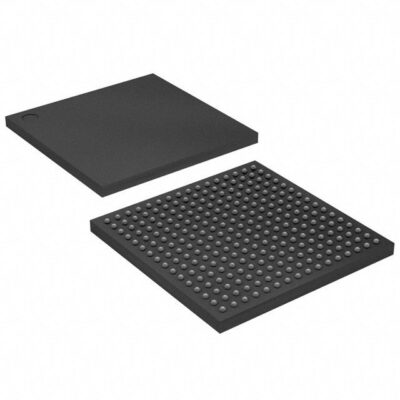EPM2210F256C5N
Part Number: EPM2210F256C5N
Manufacturer: Intel
Description: IC CPLD 1700MC 7NS 256FBGA
Shipped from: Shenzhen/HK Warehouse
Stock Available: Check with us
ICRFQ.com - Electronic Components Distributor in China Since 2003

Part Number: EPM2210F256C5N
Manufacturer: Intel
Description: IC CPLD 1700MC 7NS 256FBGA
Shipped from: Shenzhen/HK Warehouse
Stock Available: Check with us
| Datasheet | |
|---|---|
| Category | Integrated Circuits (ICs) |
| Family | Embedded – CPLDs (Complex Programmable Logic Devices) |
| Manufacturer | Altera |
| Series | MAX? II |
| Packaging | Tray |
| Part Status | Active |
| Programmable Type | In System Programmable |
| Delay Time tpd(1) Max | 7.0ns |
| Voltage Supply – Internal | 2.5V, 3.3V |
| Number of Logic Elements/Blocks | 2210 |
| Number of Macrocells | 1700 |
| Number of Gates | – |
| Number of I/O | 204 |
| Operating Temperature | 0°C ~ 85°C (TJ) |
| Mounting Type | Surface Mount |
| Package / Case | 256-BGA |
| Supplier Device Package | 256-FBGA (17×17) |
The EPM2210F256C5N is a member of the MAX® II family of instant-on, non-volatile Complex Programmable Logic Devices (CPLDs). This guide aims to provide an in-depth understanding of the EPM2210F256C5N CPLD, its features, capabilities, and potential applications. Whether you are an electronics enthusiast, a hobbyist, or a professional designer, this comprehensive article will equip you with the necessary knowledge to make the most of this powerful device.
The MAX® II family of Complex Programmable Logic Devices (CPLDs) represents a significant advancement in the world of programmable logic devices. Developed by Intel (now part of Altera Corporation), the MAX® II CPLDs are designed to provide engineers and designers with a versatile and efficient platform for implementing digital logic functions in various applications.
At the heart of the MAX® II family’s success lies its advanced manufacturing process. The devices are built using a state-of-the-art 0.18-µm, 6-layer-metal-flash process. This process technology enables the integration of a large number of transistors, capacitors, and other components into a compact and highly efficient semiconductor chip.
The 0.18-µm process node refers to the smallest feature size that can be fabricated on the chip. With smaller feature sizes, the MAX® II devices can pack more logic elements (LEs) and functionality into a smaller area, leading to higher integration levels and more capabilities.
Moreover, the 6-layer metal process provides multiple layers of interconnects, allowing for more complex routing of signals and efficient utilization of resources. This translates into faster signal propagation, reduced signal delays, and enhanced overall performance of the CPLDs.
The MAX® II family of CPLDs offers a wide range of densities to cater to various application requirements. The number of logic elements (LEs) in a CPLD determines its capacity to implement complex digital functions. With densities ranging from 240 to 2,210 LEs, designers have the flexibility to choose the optimal device size that matches their specific design needs.
In the context of CPLDs, one logic element (LE) is typically equivalent to one macrocell. A macro cell is a functional unit that can perform various logic operations, such as AND, OR, XOR, etc., along with sequential operations like flip-flops for memory. The more LEs or macrocells a CPLD contains, the larger and more complex digital designs it can accommodate.
Non-volatile storage is a crucial feature in programmable logic devices like CPLDs. It allows the device to retain its programmed configuration even when power is removed. In the case of the MAX® II family, these CPLDs are equipped with 8 Kbits of non-volatile storage.
This storage capacity is utilized to store the device configuration, which consists of the connections, logic equations, and settings that define the desired behavior of the CPLD. The non-volatile nature of this memory ensures that the configuration remains intact even after power cycles, reducing the need for frequent reprogramming and enabling the CPLD to reliably power up with the desired logic functions.
The EPM2210F256C5N is a member of the MAX® II family of CPLDs and offers a range of powerful features that make it an attractive choice for various digital design applications. Let’s delve into its key features:
The EPM2210F256C5N CPLD finds applications in various industries, including communication protocols, industrial automation, display systems, medical devices, automotive electronics, and networking equipment. It is useful for bus bridging and I/O expansion, ensuring reliable power-on reset and sequencing control. Its non-volatile configuration control allows for seamless integration into different hardware setups, streamlining development cycles.
Finally, the EPM2210F256C5N is a highly effective CPLD from the MAX® II family, boasting instant-on functionality, non-volatile storage, and flexible features. Having read this tutorial, you should feel comfortable using this programmable solution to its fullest extent, as its essential features, applications, and performance have all been addressed in detail. The EPM2210F256C5N is an excellent CPLD for anyone’s electronic applications, from seasoned pros to those just getting their feet wet.
The EPM2210F256C5N is a fantastic FPGA model that is available from ICRFQ, a top Chinese distributor of electronic components, at a competitive price. Don’t lose out on realizing your company’s full potential with the help of this innovative technology and reputable provider.
WhatsApp us